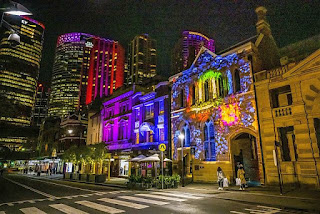 |
| Bushfires continue to rage in Australia, but we can help
(Courtesy:
80 trading 24 -- licensed under the Creative Commons
Attribution 3.0 Unported
license)
|
Presently
Australia
Though
large, Australia
 |
| Australians have a spirit all their own that is infectious -- View of Darling Harbour (Courtesy: sydney.com) |
Australians
could easily be called the "Texans of Oceania." They are fiercely
independent, passionately proud, highly competitive, vociferously opinionated
and yet, at the same time they are magnanimously friendly, charmingly
hospitable and, perhaps most admirably, dedicatedly loyal.
Most
visits to Australia begin
and/or end in Sydney , the bustling, lively
capital of New South Wales with its now iconic
opera being as familiar a landmark for Australians as are the Eiffel Tower
Regarded
as one of the 20th century's most famous and distinctive buildings, the
gleaming white layered shell-shaped Opera House Performing Arts Centre at Sydney Harbour
 |
| Sydney Opera House (Courtesy: public domain pictures) |
Adjacent
to Sydney 's city center is Darling Harbour
Always a
favorite spot, even if travelers have never heard of the district until they
arrive, is The Rocks, an urban tourist precinct and historic area in Sydney's city
center near the opera house.
 |
| The Rocks is lively and colorful (Courtesy: sydney.com) |
The Royal Botanic Garden is the most
important green space in Sydney
Fifteen
separate parks within the city center include Hyde
Park, The Domain and Prince Alfred Park.
But
these are merely appetizers which most avid travelers easily discover on their
own.
 |
| The Royal Botanic Garden looks out toward the Opera House (Courtesy: visitsydney.com) |
Beyond Sydney , just a two hour drive west, are the Blue Mountains with their seemingly infinite stretches of
eucalyptus trees. This UNESCO World Heritage area boasts of 87 miles of walking
trails that include native bush-lands, impressive rock formations and underground
caves.
Here you
can be entertained by stories told by local Aboriginal guides and also admire
the craftsmanship of resident artisans.
 |
| The Blue Mountains beckon (Courtesy: pixabay) |
Be sure
to dine at Darley's Restaurant and don't forget to sample some of Australia 's famous Blue
Mountains wines.
 |
| Uluru, more familiarly Ayers Rock, is worth a visit (Courtesy: pixabay) |
The area
around the formation is home to an abundance of springs, waterholes, rock caves and ancient
paintings, and is listed as a UNESCO World
Heritage Site.
Another
UNESCO World Heritage Site, the Great Barrier Reef is the world's
largest coral reef system off the coast of Queensland
 |
| UNESCO's Great Barrier Reef (Courtesy: pixabay) |
It is
the world's biggest single structure built by billions of tiny living organisms
known as coral polyps.
Selected as a World Heritage Site in 1981, CNN has labeled the
Great Barrier Reef as one of the seven natural wonders of the world.
If this
was a normal travel story, this is where it would end, but this time the story
is not typical. The places in Australia
listed above are traveler's favorites, just as Australia
The sites
and attractions mentioned above are little more in this article than scene
setters to whet our wanderlust appetites and to remind us of what could be lost
forever.
 |
| Colorful Darling Harbour (Courtesy: sydney.com) |
For those
of us who have savored the beauty of Australia
Contact Australian Red Cross' Disaster Relief and Recovery, or get
in touch with WIRES, an organization committed to wildlife in Australia.
You can also donate to local fire brigades.
To
support people affected by the fires, Fast Company suggests donating to the Salvation Army’s disaster appeal or the bushfire appeal fund set up by the St. Vincent de Paul
Society.
The
fires have made Australia's declining koala population more vulnerable than
ever; consider a donation to the
 |
| Koalas were struggling to survive before the fires (Courtesy: pixabay) |
As Executive Editor, George Stone of TRAVEL, a publication of National Geographic, so appropriately writes, "It's not enough to love a land only when the sun shines. Now is the time to care for a faraway place as if it were our own backyard."







0 comments:
Post a Comment